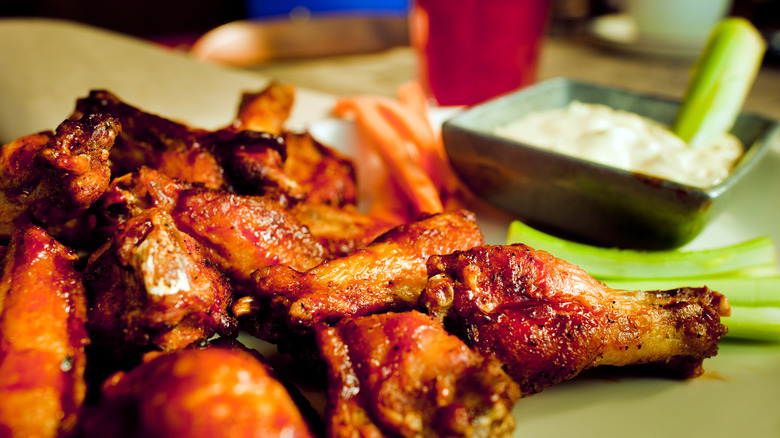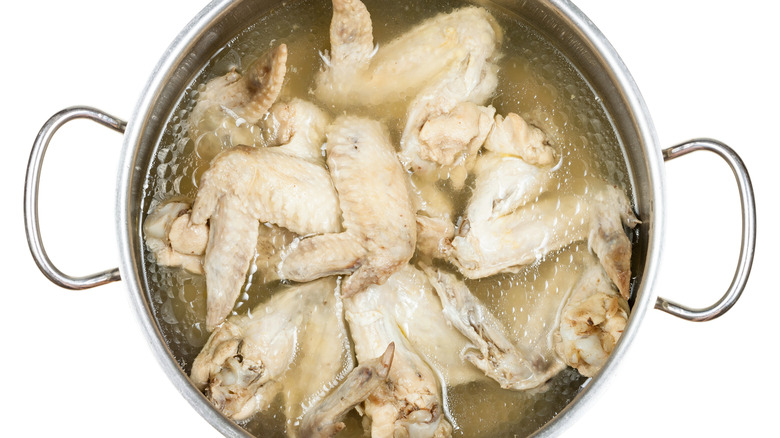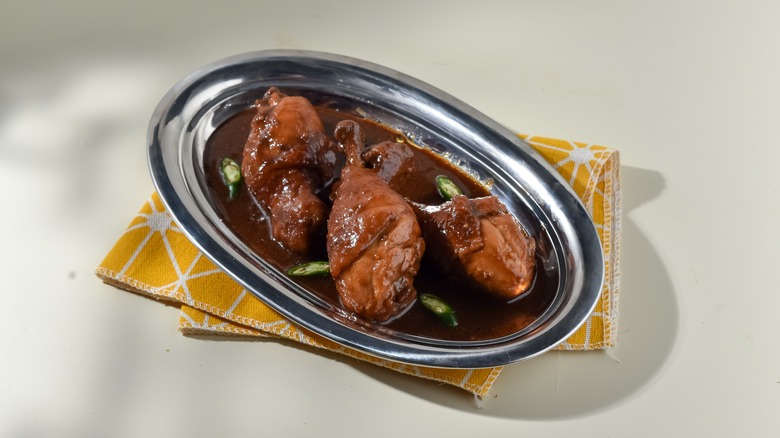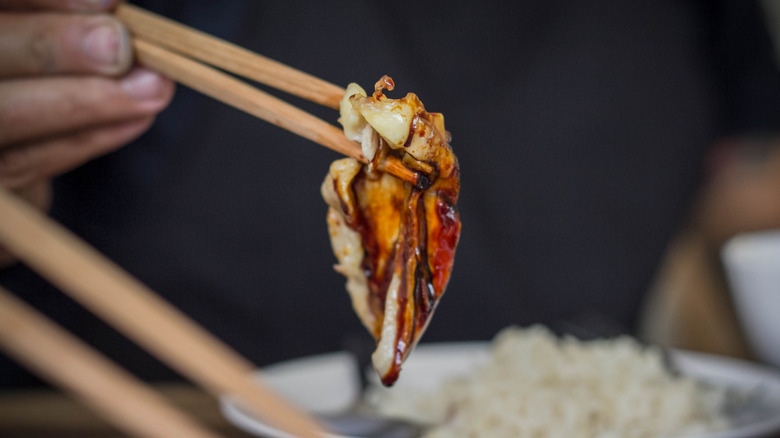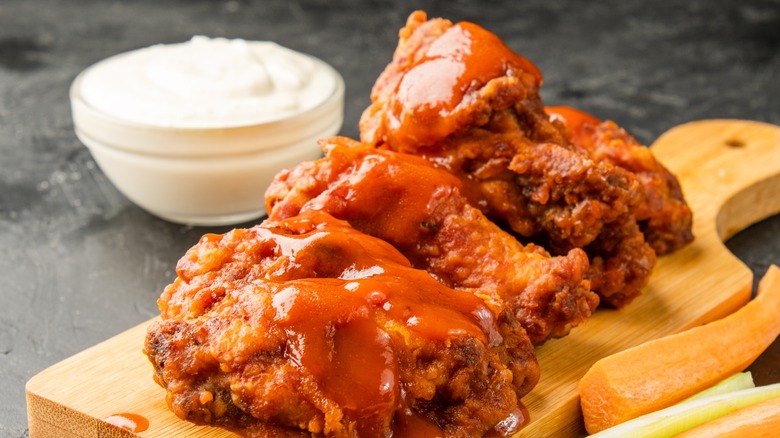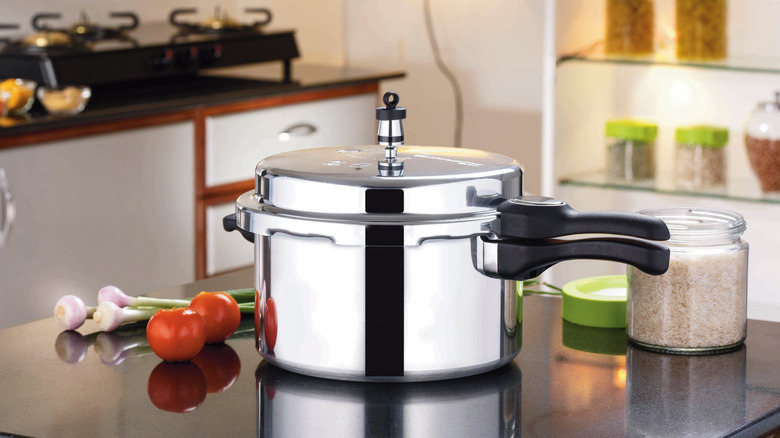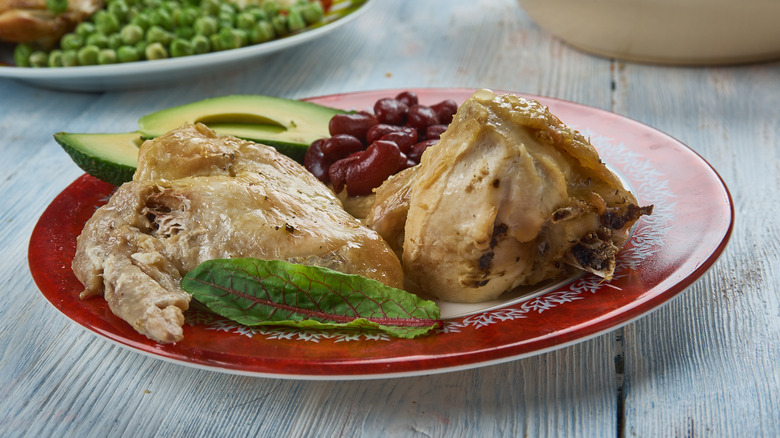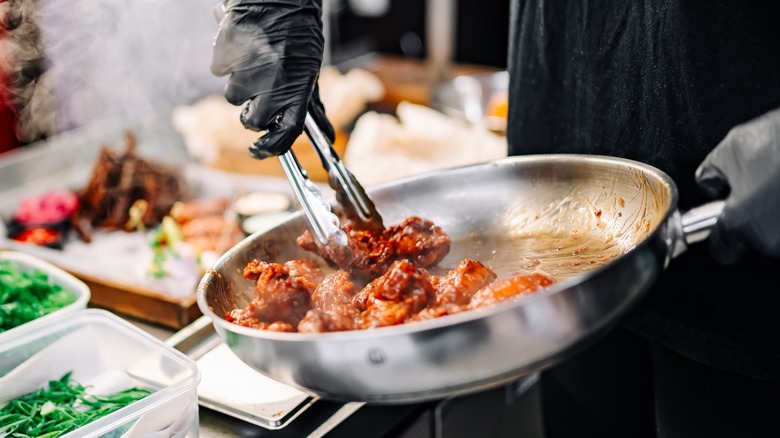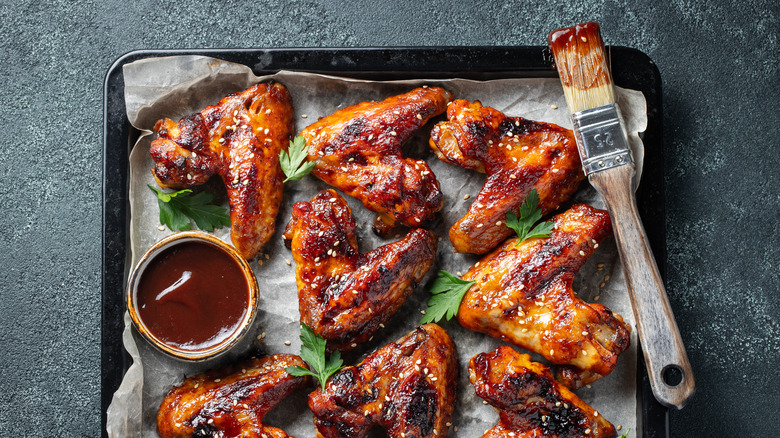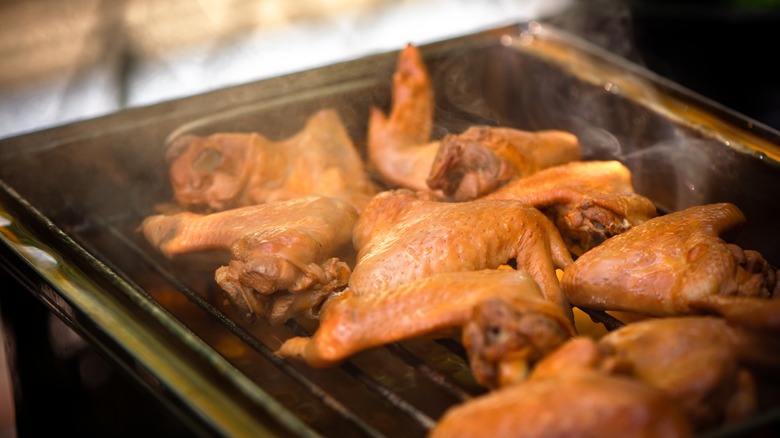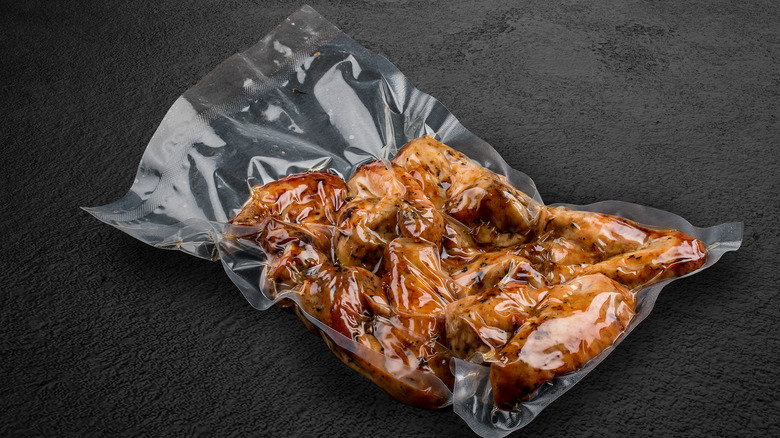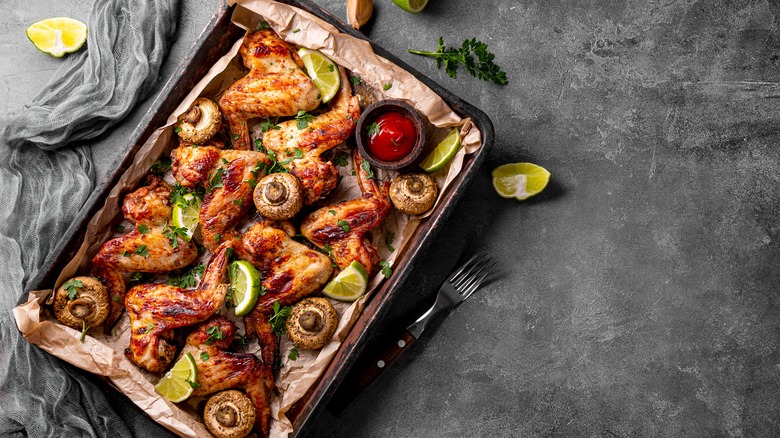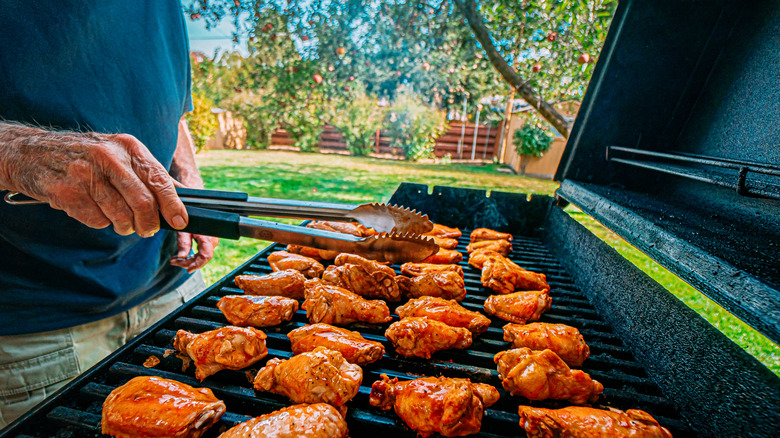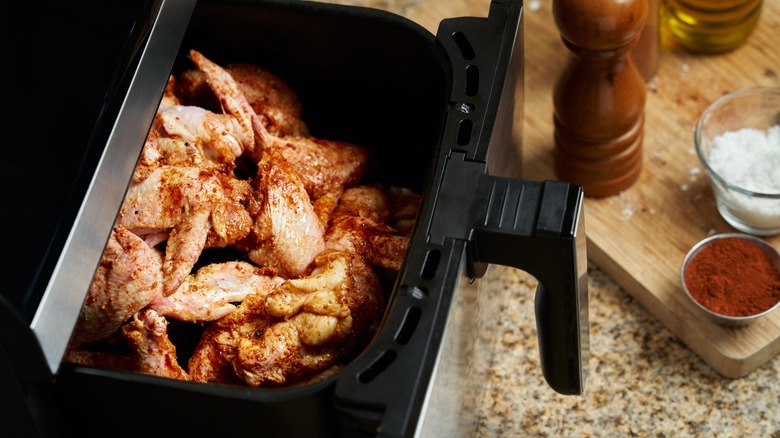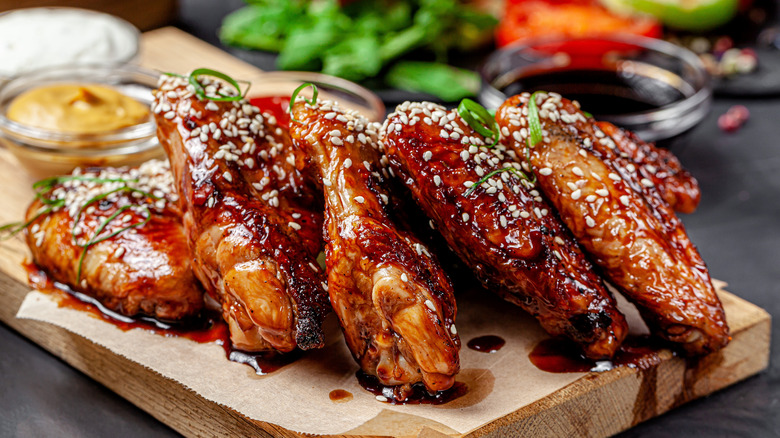Every Way You Can Cook A Chicken Wing, Ranked
Perfectly cooked chicken wings are one of the culinary world's greatest pleasures. When made properly, the meat is tender and succulent, and the skin of the wing offers an undeniably satisfying crunch.
Taste aside, chicken wings are also a great source of protein, and convenient to make in batches, making them ideal as an appetizer, entrée, or even a sharing platter. They're also extremely versatile, with countless ways to marinade, season, and sauce them to your own liking.
There are plenty of handy tips and tricks out there for seriously elevating your homemade chicken wings, but these aren't as important as how you cook them. In terms of cooking methods, there are probably more than you think, and we've listed and ranked all of them below to help you master your wing game. I've tried and tested every single one of these chicken wing cooking methods, both at home and over a long career in the restaurant industry, including a spot that offered unlimited wings on a weekly basis. Different cooking methods produce varying styles of wings, so the rankings are a little subjective; however, they're based on what I've found the majority of people to prefer, and you'll still be able to find the best method for your personal tastes.
Boiling
While it is possible to cook chicken wings by boiling them in water, this method has too many drawbacks to make it worthwhile. Not only are flavors lost as the meat is exposed to high temperatures, but some of the chicken wings' nutrients will also leech into the water, ultimately reducing the health benefits of the food. You can remedy the loss of flavor by seasoning the water or using a robust stock, but it's nowhere near as effective as any of the other cooking methods available.
There's also the issue of texture — one of the best things about chicken wings is the deliciously crispy skin, and boiling wings means you'll miss out on this part of the experience. Plus, crisping up the skin with dry, direct heat allows the Maillard reaction to occur, browning the exterior and releasing even more flavor. It's also possible to over-tenderize the wings by boiling them, so not only will you miss out on the crunchy skin, but the meat itself may become too soft.
That said, boiling can be used effectively in conjunction with other cooking methods. If you boil your wings for about 7 minutes before baking, the hot water will render off some of the fat, resulting in crispier skin and helping the meat retain moisture.
Poaching
Poaching is somewhat similar to boiling in the sense that the chicken wings are being cooked with hot water, but the temperatures used are lower. Truthfully, the poaching method comes with many of the same drawbacks as boiling.
You'll still experience a loss of flavor and nutrients, but you can improve the taste by soaking the wings in salt water in advance and getting creative with your liquid. Although poached chicken wings aren't particularly popular in Western cuisines, they're a common feature overseas, particularly in China. If you're interested in trying out the poaching method, it's a good idea to draw inspiration from Chinese recipes for the best results.
For instance, you can create a briny broth with ingredients like chicken stock, Sichuan peppercorns, ginger, star anise, and Shaoxing wine for poaching. After your wings are cooked through, you can chill them in an ice bath to firm up the skin and refrigerate them with the flavor-packed cooking liquid to create a briney jelly. Although this might seem like a far cry from most traditional recipes, it can be a delicious way to prepare chicken wings if you're interested in trying something new.
Steaming
If you prefer softer-skinned wings and want to avoid cooking with excess fat or oil, steaming is the best method to go for. You'll end up with a similar taste and texture to poached wings, but steaming is much better for preserving flavors and nutrients.
Again, steaming isn't a particularly common cooking method for wings in Western cuisines, but you'll find plenty of recipes from Asia. For the best results, you'll first want to marinate the wings for at least an hour. However, the longer you can let your wings soak up those extra flavors, the better, so for best results, try and leave them overnight. You can experiment with whatever marinades you like, but again, the safe bet is to take notes from Chinese cuisine.
Chinese cooking wine combined with salty soy sauce and oyster sauce is perfect for adding umami, while ginger, spring onions, and sesame oil are perfect for nailing those Eastern flavors. Shiitake mushrooms are another great addition, but if they come dehydrated, you'll need to soak them for a few hours before adding them to your sauce. All in all, it should only take about 20 minutes to steam the chicken wings, but this method does require a fair amount of advance preparation for the best results.
Deep frying
For many people, chicken wings are at their best when they boast a crunchy golden skin, something that's most often achieved by breading the wings and deep frying them in oil. The enhanced exterior texture also makes it much easier for sauces to cling to the wings, offering a wide range of delectable flavor options.
However, successfully deep frying chicken wings is harder than you might think, and one could argue that this is a complicated dish that's not worth making at home. For the most succulent wings, you'll want to soak the chicken overnight in buttermilk to tenderize the meat and infuse it with flavor. Then, in separate stages, you'll need to dredge the wings in flour, egg wash, and your preferred breadcrumb mixture.
Deep frying chicken wings requires significantly more oil than other cooking methods, which can pose problems of its own. Without a deep fryer, you'll likely be limited in how many wings you can cook in a single batch. You're also dealing with large quantities of hot oil, which can pose a safety hazard without experience, the right equipment, and a suitable disposable method.
Pressure cooking
Pressure cookers can be an excellent way to speed up cooking times, and they effectively work by steaming the food within. However, the higher temperatures involved mean it's extra important to get the timing spot on.
When timed correctly, pressure cooking will result in beautifully tender chicken, and it can be a great option when you're stuck with tougher, lower-quality wings. However, if you cook the meat for too long, it will become overly tender before eventually drying out. You're also going to miss out on the crispy exterior unless you bake or shallow fry the chicken once it's out of the pressure cooker, adding to your overall cooking time.
One solution to this drawback is a technique called pressure frying, but it tends to require specialist equipment that you might not find outside of the food service industry. If you do attempt pressure frying at home with a standard pressure cooker, it's critical you read the appliance guidelines on how much oil can be safely used — if any — to prevent hurting yourself or damaging the equipment.
Slow cooking
While the two can look pretty similar, the cooking methods employed by a pressure cooker and a slow cooker are almost complete opposites. The former uses high temperatures that result in much shorter cooking times, while the latter uses low temperatures over a much longer time period to tenderize food and allow flavors to develop.
Although slow cooking takes longer, this is usually a point of convenience, as it enables you to throw your ingredients into the pot and go about your day, coming back later to a perfectly cooked meal. However, depending on the size of your slow cooker, you might find some recipes need adjusting, especially when it comes to the amount of liquid you add. As with other methods that don't use direct, dry heat, your wings won't develop a crispy exterior without time in the oven, and it's possible to overcook them. Slow cooking can result in incredibly tender meat that practically falls off the bone, but if the chicken is too lean, overcooking will destroy the texture, turning the chicken into a soft, dry, paste-like substance.
Pan frying
Using a frying pan to cook chicken wings is an extremely versatile method that has a lot of benefits and few drawbacks. However, to start, you'll need to pick the best pan for the job.
A cast iron pan is arguably best, as the walls are high enough to prevent the oil from making a mess and, if it's well-seasoned, you shouldn't run into issues with the wings sticking to the base. You can also crank up the heat if you're after an extra crispy skin. Pan frying gives you a lot of options in terms of seasonings, and you won't need anywhere near as much oil as deep frying. You'll be able to achieve a nice golden exterior by pan frying, but it's not the best method if you're after a truly noticeable crunch.
Although this method requires keeping a close eye on your wings while they cook so you can monitor doneness and flip them partway through, this isn't too problematic as it's a relatively speedy process overall. The biggest downside to pan frying is arguably the amount of wings you can cook in a single batch, as you'll be limited by the size of your pan.
Broiling
These days, most ovens come with a feature called a broiler — a function that produces phenomenal cooking results but can be tricky to use without a bit of know-how. Broiling essentially relies on cranking up the temperature on the top element of the oven so that it applies high, direct heat to the food below.
There are arguably few better methods for achieving a crispy, brown exterior on food than using the broiler, and it's just as versatile as pan frying in terms of the seasonings you can add to boost flavor. The increased temperatures used in broiling also mean it's one of the quickest methods for cooking wings, but it requires close attention, as it can take just moments for the exterior to burn if you're not careful. Although you can prepare chicken wings fully under the broiler, a more common approach is to cook the wings with an alternative method first and then use the broiler for just a few minutes as a finishing touch to crisp up the skin before serving.
Smoking
Although not everyone enjoys the taste of smoked meat, for fans of the flavor, there's no better method than using a smoker to cook chicken wings. Not only does it imbue the chicken with a rich barbequed essence, but it's also excellent for producing tender wings, and for cooking in large quantities.
It's even possible to get the skin nice and crispy with the smoking method, as long as you dry the wings as much as possible before cooking and using a coating of baking powder to remove moisture. The most common issues people have with smoking are the equipment required, the technical knowledge needed, and the time it takes. The good news is that you don't necessarily need a purpose-built smoker to smoke chicken wings — you can turn your gas grill into a smoker with a simple hack. But, you'll still need to have a good awareness of appropriate cooking times and temperatures. Not only do you need to keep a close eye on how hot your smoker gets, but you'll likely need to top up on wood chips throughout the cooking process. Overall, smoking takes longer than most other cooking methods, but the results are always worth it if you're prepared to put the effort in.
Sous vide
Meaning "under vacuum" in French, cooking sous vide is pretty much unbeatable as a method for achieving incredible consistency and textures in everything from steak to eggs. However, it does require some specialist equipment and know-how.
The good news is that sous vide equipment is relatively inexpensive these days, and it's relatively simple to get your head around. The first step is to vacuum seal your chicken wings — this is traditionally done in single-use plastic bags but it's possible to find reusable silicone bags that can save on money and waste.
Next, the bag is placed in a water bath with a unit that carefully regulates the temperature of the water while evenly circulating the heat. This method cooks the meat extremely slowly but ensures edge-to-edge cooking perfection. If you're after a crispy exterior, you'll need to let the wings air-dry before finishing them in the oven or under the broiler. Although cooking chicken wings sous vide isn't the most cost- or time-effective method, once you've had the pleasure of trying them, you'll find it hard to look back.
Baking
Baking chicken wings in the oven is arguably the most convenient cooking method and offers a superb balance between consistency, flavor, and texture. Although there are faster ways to cook wings and methods that produce crispier skin, these drawbacks are negligible for most people.
Although marinating the wings will produce the tastiest results, it's in no way compulsory as long as you don't skimp on the seasonings when you toss them with a little oil. Using a baking tray also lets you cook more wings in one go, which is ideal for when you have to feed extra mouths. The high heat in the oven will also render most of the fat in the wings, which helps the skin crisp up, especially if you add a little baking powder to your seasoning mix — the underrated ingredient for crispy wings.
If the skin still isn't quite done to your liking, you can simply move the wings to the top of the oven and fire up the broiler for a few minutes. Baking is also the best way to reheat and revive leftover wings if you want them to taste as close to fresh as possible.
Grilling
It's tricky to pick between baking and grilling for cooking chicken wings as both can produce excellent results. Ultimately, it's down to a matter of preference as they each have their own perks.
Both methods are equally versatile when it comes to customizing flavors, so you can still marinade the wings beforehand and take your pick of sauces and seasonings. Grilling can be slightly quicker than baking, but you do have less control over the temperatures which means needing to keep a closer eye on the wings while they cook. The biggest upside is that you'll get more of that rich, smokey barbeque flavor using the grill and a nice char, and depending on the size of your grill, you might even be able to cook larger batches in one go.
The main drawback to using the grill is that it can be weather-dependent — it's perfect when the sun is shining and you can host people outside, but you're limited when the weather puts a damper on things. Grilling goes a long way toward attaining crispy skin but, like with baking, you may want to finish them off under the broiler.
Air frying
No matter how many methods we've tried, there's one that never fails to produce incredible chicken wings. With an air fryer, the chicken comes out tender and juicy, and you'd be forgiven for thinking the wings had been deep fried based on their crunchy golden exterior.
The name "air fryer" is a little misleading in the sense that it's not actually frying anything; rather, it cooks the food within by rapidly circulating hot air inside the appliance. This can make food almost as crispy as if it were fried, but with the upside that you can use a fraction of the oil, making the process both safer, more convenient, and healthier.
The only real drawbacks to air frying wings are that you're limited by the size of your appliance and that over-using dry seasonings is a costly mistake, as it can clog the filter. This is where a little oil comes in handy, as it helps herbs and spices stick to the chicken during cooking. Air frying wings doesn't take long, only requiring about 20 minutes of cooking time in total — depending on the size of your wings — and a quick flip halfway through. The good news is that the popularity of air fryers means they're now extremely good value for the money, especially when you consider just how many foods you can use them for.
Methodology
The cooking methods in this article have all been personally tried and tested by the author on multiple occasions, in professional kitchens and at home. The rankings are based on a method's overall effectiveness, meaning its ability to produce delicious, juicy chicken wings that retain as much of their flavor and nutrients as possible. While preference for a crispy exterior can be subjective, these rankings assume it is the most desirable outcome. The rankings also factor in the ease of the method, the accessibility of the equipment required, and the overall cooking times.

